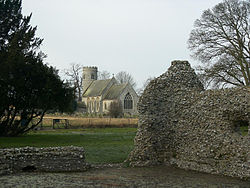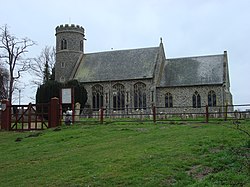Weeting
| Weeting | |
| Norfolk | |
|---|---|
 Weeting St Mary, seen from the ruin of Weeting Castle | |
| Location | |
| Location: | 52°28’24"N, 0°37’52"E |
| Data | |
| Post town: | Brandon |
| Postcode: | IP27 |
| Dialling code: | 01842 |
| Local Government | |
| Council: | Breckland |

Weeting is a village in Norfolk, close to the border with Suffolk and the town of Brandon. The relevant civil parish is Weeting-with-Broomhill.
Churches
Its church, St Mary, stands close to Weeting Castle, and is one of 124 existing round-tower churches in Norfolk. Another church, All Saints stood 500 yards south of St Mary's, but was destroyed by the fall of its tower in c.1700. The site is still visible today, with various grave markers lining a fence on the south side of the old churchyard, and a high mound marks the location of the church foundations. During dry spells, the crop-mark outline of All Saints can be clearly seen, and some flint remains of the tower, south aisle wall, and east wall are just breaking the surface.
History
During the 1920s and 1930s, Weeting housed a Ministry of Labour work camp. Basing its operations in the eighteenth century Weeting Hall, the Ministry of Labour opened a residential training centre in 1926, aimed at helping unemployed men - particularly war veterans - to acquire basic agricultural techniques. The centre had a capacity of 200; of these, three quarters were expected to emigrate to countries such as Canada or Australia. The training programme initially consisted of a 'testing period', involving heavy manual tasks such as road-making and log-splitting; those judged suitable were then trained in dairy work, ploughing, horse management, rough carpentry and seed planting.
By 1929, the policy of overseas emigration was under severe pressure. High unemployment in the Dominions led to a sharp decline in demand for freshly trained British workers, and the collapse of mining and heavy manufacturing at home had produced new pressures. Weeting Hall was redesignated as an Instructional Centre, taking in young long-term unemployed men from the depressed areas and giving them a three-month exposure to heavy manual work. The Ministry sometimes described this as a "reconditioning" process, which hardened up young men who had gone "soft" through prolonged unemployment. While some of the trainees did find work as a result, quite significant numbers were either dismissed or walked out - despite the risk to their benefits. Weeting was one of a number of work camps opened by the Ministry rising to a total of 35 by 1938; by the summer of 1939, with unemployment falling as war became imminent, all were closed, and several were turned over to other uses. Weeting Hall, which was used to house wounded Indian and Gurkha soldiers during the Second World War, was demolished in 1954.
Weeting has many thatched cottages and is home to one of the longest continuous lines of thatched roofed houses. Unfortunately in January 2007 the thatched roof caught fire initially only damaging one house, however four years later another fire ravaged one half of the whole row. The row is believed to be dated between the eighteenth and nineteenth century.
References
- Field, J. Learning Through Labour: Training, unemployment and the state, 1890–1939, University of Leeds, 1992, ISBN 0-900960-48-5
Outside links
- Website with photos of Weeting St. Mary, a round-tower church
- News.BBC.co.uk n BBC News report about thatched fire.